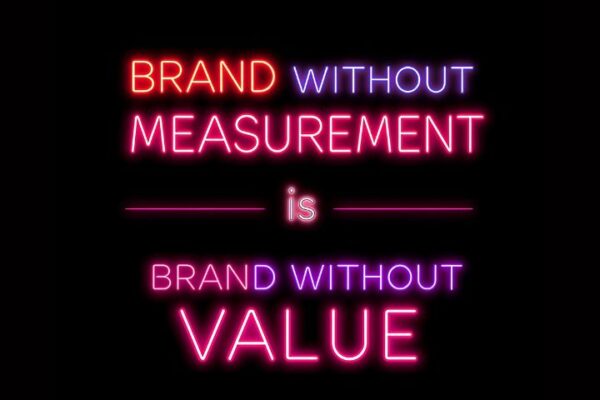Brand is now one of the UK’s most valuable business assets, yet it remains one of the least measured. Investment in branding rose by more than £3 billion in 2022, according to the Office for National Statistics; however, many organisations still struggle to demonstrate what that investment actually delivers.
Every boardroom talks about brand, but few can prove its impact. While reputation and trust account for a significant share of corporate value, the absence of credible measurement means many UK businesses are managing their most important asset in the dark.
The risk is real. Decline rarely happens overnight. Falling trust, shrinking loyalty, and weakening market share are almost always signalled in brand performance data long before financial results reveal the damage. Without tracking, those early warnings are missed, and leaders are left to respond after value has already been lost.
Why Tracking Brand Performance Matters
Brands influence far more than short-term sales. They support pricing power, protect margins, attract talent and reassure investors. A strong brand provides resilience in volatile markets, where customers default to names they recognise and trust. When performance is tracked consistently, leaders gain an early warning system that shows whether investment is building durable equity or simply fuelling short-lived attention.
The risks of neglect are serious. Without evidence, the brand is dismissed as a discretionary cost rather than a driver of growth. In downturns, budgets disappear. Early signs of trouble, such as declining trust, weakening consideration or rising customer churn, are overlooked until financial results reveal the damage. Research shows that more than 80 per cent of UK consumers feel undervalued by the brands they prefer. That is not a minor irritation. It is a signal of eroding loyalty in a market where new customer acquisition is already expensive.
For boards, the conclusion is simple. A brand that is not measured cannot be valued. And if it cannot be valued, it cannot be defended.
What Businesses Should Be Measuring
Measuring brand performance should not be reduced to vanity metrics. Awareness alone tells us little. For example, YouGov data shows that Kia enjoys more than 90 per cent recognition in the UK, yet this awareness does not automatically translate into purchase intent.
A full view of brand performance should cover:
- Awareness and salience: whether the brand comes to mind at the point of decision.
- Consideration and preference: whether awareness converts into choice.
- Perceptions of quality and value: how customers view the brand on product, service and price.
- Trust and reputation: whether stakeholders believe the brand delivers on its promises.
- Customer experience: the quality of interactions across channels.
- Financial outcomes: the ability to support price premium, retention and market share.
The fundamental insight emerges from examining these signals in conjunction. A decline in trust may matter more than a rise in awareness. A sudden decrease in consideration may indicate a pricing issue, a service failure, or a reputational risk. Without tracking, these dynamics remain invisible.
The UK Context
The urgency is heightened in the UK, where intangible assets dominate corporate value but are poorly accounted for. Most brand investment is expensed rather than capitalised, leaving little trace in financial statements. The UK Endorsement Board has highlighted this gap, warning that companies risk under-representing assets that drive long-term value.
At the same time, UK consumers are demanding more. The majority already feel undervalued by the brands they buy from. Expectations around transparency, responsibility and service continue to rise. In markets where product features or service offerings alone rarely differentiate, reputation and trust are decisive. Yet they are fragile. Without tracking, leaders may discover too late that loyalty has weakened and price sensitivity has increased.
Avoiding the Pitfalls
Many organisations struggle when attempting to measure brand performance. Some collect too much data without clarity of purpose, producing dashboards that overwhelm rather than inform. Others rely solely on lagging indicators such as sales or market share, which only reveal problems after the damage is done. Still others chase surface-level numbers such as likes or followers that may flatter but rarely connect to business outcomes.
The solution is to focus on a balanced set of leading and lagging indicators, to benchmark results against competitors, and to ensure data is interpreted in context. Measurement must be continuous, consistent and embedded into decision-making, not an annual survey filed away in a report.
The Role of Leadership
Treating a brand as a strategic asset requires active involvement from leadership. Boards should expect to see brand performance tracked alongside financial performance. CFOs should collaborate with CMOs to develop metrics that link intangible strengths to tangible outcomes. CEOs should champion investment in measurement, recognising that resilience in uncertain markets depends as much on reputation and trust as it does on operational efficiency.
Most importantly, measurement must lead to action. If the data indicates a decline in trust or a falling preference, leaders must be prepared to respond. This may involve improving service, addressing product quality issues, or modifying the brand’s engagement strategy with stakeholders. Measurement is not a defensive exercise. It is a foundation for proactive leadership.
Long Story Short
A brand is only as strong as the evidence behind it. In an era when intangibles dominate corporate value, failing to track brand performance is not a harmless omission but a strategic risk. UK companies are investing more in brand than ever before. Those who measure rigorously will be able to defend that investment, allocate resources wisely and build long-term equity.
The organisations that thrive will not be those with the loudest campaigns. They will be the ones who can demonstrate with clarity and confidence that their brand is delivering measurable value. Without measurement, a brand has no value. With it, the brand becomes a managed, measurable and defendable strategic asset.
Want to turn your brand into a measurable strategic asset? Let’s discuss how to track what matters and demonstrate the value of your investment.






